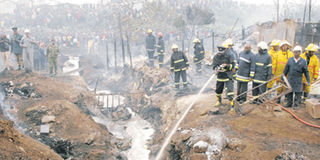‘I’d never seen so many bodies in 23 years as firefighter’

Firemen fight to contain the fire that killed more than 90 people in Nairobi’s Sinai slums. Photo/NATION
It was 10.35am on Monday morning when the phone call came in to the fire brigade offices on Tom Mboya Street. It was a call from the police. There was a fire at Sinai slums.
It sounded the same as any other fire that firefighter Joseph Oginga, 52, had handled in the 23 years of his career; it first hit him as “another slum fire.”
But Mr Oginga was about to see the most bodies he had ever seen at one location.
The firefighter did not hesitate to ring the alert siren, and made the announcement on the loud speaker to have the firemen and the ambulance on the move towards the sprawling informal settlement.
It never crossed the minds of the rest of the six men on his team that it was the worst inferno in recent times.
But at the back of their minds, were the scathing attack the department receives from the media and the public, Mr Oginga confessed.
The roaring fire engine set out by 10:36am with the six men on board, among them Daniel Irungu and Julius Nyapeni who has been a fire man for six years.
The used Jogoo Road to connect to Lunga Lunga, but on reaching House of Manji factory, the traffic ground to a halt.
The opposite traffic, according to Mr Oginga, was clogged with saloon cars transporting people with burn injuries. Smoke and huge flames bellowed into the sky.
Mr Oginga remembers saying: “Naona hii moto ni mbaya (This fire looks terrible).”
With the help of the public, the fire engine snaked its way until they reached a vantage point.
Mr Oginga already had a strategy on how to cut the fire from spreading.
He noted that a fire engine stationed at Enterprise Road had already gone to the scene, from the other side of the slum near Tetra Pak.
“Were it not for this team already on site, this fire would have spread to Mukuru kwa Reuben which would have been more disastrous,” he told the Nation.
He noted that the fire was spreading in the same direction as the people who were ferrying fuel were moving in two opposite directions; human beings had become mobile fires, igniting other structures in their wake.
G4S team
Mr Oginga alerted the G4S team to focus on the right side of the fire, while his team concentrated on the left blaze. Soon, his men and were able to contain it.
All this time they had not seen a single body. The steep hill towards the river and the smoke and flames concealed the mounting death toll.
“It was after we quelled the smouldering fires that we were able to get to the man hole where the fire must have originated.
“We stumbled upon the first body of a man who had burnt to death looking up while clutching a 20 litre jerrican,” he said.
In a matter of seconds, the bodies came into view, and the full magnitude of the tragedy hit his men.
Corpses were sprawled all over the place, some piled on top of each other, a scene that was horrifying, even as this was not their first time to quell fuel fires in the slum.
“I have been to the same place three times in the past, but during those incidents only three or so people are burned or injured,” he said.
His biggest worry is whether the residents will learn from this experience.
Part of their activity on the fateful day was having residents surrender the illegal fuel which they had with them, something which they did hesitantly.
“We moved from house to house, but the danger was that some people were throwing the fuel carelessly in fear of being arrested. These would end up bursting into flames,” he added.
The work they did that day has not gone unnoticed, with the Town Clerk, Philip Kisia saying the firemen did a superb job.
“Despite the numerous challenges my team was able to reach on site in a record ten minutes and a manage to put out the fire in 40 minutes,” said Mr Kisia.
The fire burned the better part of the Sinai slums, and left more than 90 people dead and hundreds of families homeless.
One firefighter recalled how on arrival, some four young gun-toting men asked them to start with a certain side of the slum in putting out the fire.
An old man watching the scene unfold told the fireman: “These are the people who call the shots here, just comply.”
The slum has a “government” of its own.
Gathered at a round table next to the report office, the team was eager to share their experiences at some point with the Nation.
Trouble is, they did not want to allowing any one of them speak at a time. They all spoke.
But one thing was clear. They were all proud of their work, especially saving lives.
During the interview, the firemen said that the worst of their experience was being pelted with stones “for arriving late”.
Other times a hoax fire alarm leads them instead, to a place where an armed robbery is about to take place.
As the fire engine arrives, they have the owners of the house clutching them in joy for having saved them, since the armed robbers often disappear at the sound of a siren.




